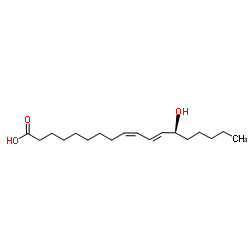Roles of peroxisome proliferator-activated receptor-alpha and -gamma in the development of non-small cell lung cancer.
Ming-Yue Li, Huiling Yuan, Lily T Ma, Angel W Y Kong, Michael K Y Hsin, Johnson H Y Yip, Malcolm J Underwood, George G Chen
Index: Am. J. Respir. Cell. Mol. Biol. 43(6) , 674-83, (2010)
Full Text: HTML
Abstract
Peroxisome proliferator-activated receptor (PPAR)-α and PPARγ participate in cell proliferation and apoptosis. Few studies have simultaneously investigated both PPARα and PPARγ in lung cancers in vivo. The roles of PPARα and -γ were investigated in the development of pulmonary tumors induced in the adult A/J mouse by treatment with 4-(methylnitrosamino)-l-(3-pyridyl)-lbutanone (NNK). Compared with the normal lung tissues, PPARγ expression was much higher in the NNK-induced lung tumor tissues. However, PPARγ transcriptional activity, and the levels of two major endogenous PPARγ ligands, 13-hydroxyoctadecadienoic acid and 15-hydroxyeicosatetraenoic acid, were significantly lower in the NNK-treated lung tissues. The ligand changes in mice were confirmed in human lung cancer tissues. Along with the alteration of PPARγ and its endogenous ligands, the level of PPARα and its activity were increased in the NNK-induced mouse lung tumors. Treatment of mice with the synthetic PPARγ ligand, pioglitazone, significantly inhibited the formation of mouse lung tumors induced by NNK. Our study demonstrated that the reduction of endogenous PPARγ ligands and increased PPARα occurred before the formation of lung tumors, indicating that the molecular changes play a role in lung carcinogenesis. The results suggest that the enhancement of PPARγ activity with its ligands, and the suppression of PPARα with its inhibitors, may prevent the formation of lung tumors, as well as accelerate the therapy of lung cancer. Our findings may also reveal the possibility of using the level of endogenous PPARγ ligands and the activities of PPARγ or PPARα as tumor markers for lung cancer.
Related Compounds
| Structure | Name/CAS No. | Molecular Formula | Articles |
|---|---|---|---|
 |
13S-hydroxyoctadecadienoic acid
CAS:29623-28-7 |
C18H32O3 |
|
Light exposure at night disrupts host/cancer circadian regul...
2014-01-01 [PLoS ONE 9(8) , e102776, (2014)] |
|
Doxorubicin resistance in breast cancer is driven by light a...
2015-08-01 [J. Pineal Res. 59 , 60-9, (2015)] |
|
Implications of chemokines, chemokine receptors, and inflamm...
2014-04-01 [J. Leukoc. Biol. 95(4) , 575-85, (2014)] |
|
Effect of ω-3 and ω-9 fatty acid rich oils on lipoxygenases ...
2010-01-01 [Lipids Health Dis. 9 , 112, (2010)] |
|
Ligand-induced formation of transient dimers of mammalian 12...
2012-03-01 [Proteins 80(3) , 703-12, (2012)] |